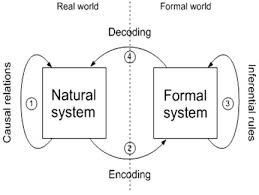The gnoxic meaning-cycle diagram, and Rosen’s diagram of the modeling relation, are diagrams of semiosis, Thirdness and thought in the Peircean sense. As Peirce said (Chapter 10), ‘Thirdness is found wherever one thing brings about a Secondness between two things.’ This follows from Peirce’s highly abstract definitions of the elements of the phaneron:
Firstness is that which is such as it is positively and regardless of anything else.
Secondness is that which is as it is in a second something’s being as it is, regardless of any third.
Thirdness is that whose being consists in its bringing about a secondness.
EP2:267
The ‘something’ or subject in the mode of being called Secondness is as it is in being Second to something else, an Other (but not a significant Other, as significance would be a third). In our gnoxic diagram, W exists as such by virtue of its Secondness to the system or subject to whom it is external; and this Secondness or reactivity is mutual. On the other side of the diagram, M is a ‘model’ by virtue of its dyadic relation to W, a secondness ‘brought about’ by semiosis, the process represented by the arrows in the diagram. But within that process, M can be regarded as a sign which, in its Thirdness or mediation between the subject and its world, brings them into actual relation with each other by directing the actions and attention of the subject (upper arrow), while also being an interpretant of a perceptual sign-complex.
The lower arrow in our diagram represents the action of a ‘natural sign’ in bringing about a subject’s experience of that other subject which is the object of that sign; the Secondness is the experiential relation or ‘reaction’ between those two subjects. The upper arrow represents the action of an intentionally ‘uttered sign’ (Peirce, CP 8.348, EP2:484), or an act of communication directed from one subject (the utterer) to another (the interpreter), which brings about in the latter subject the embodiment of a Form which was already embodied in the former. This ‘embodiment’ or alteration of bodymind is a Secondness brought about by the sign.
Another way of reading the diagram would see the lower arrow as representing the compulsiveness of W’s effect on M in perception, while the upper arrow represents the effect of actual practice on W. Each of these is a Secondness brought about by the function of the guidance system (the modeling relation, the meaning cycle) which governs both ception and practice. In ception, ‘the third is thought in its role as governing Secondness. It brings the information into the mind, or determines the idea and gives it body. It is informing thought, or cognition’ (CP 1.537). In practice, the Thirdness is that of ‘a habit, which determines the suchness of that which may come into existence, when it does come into existence’ (Peirce, EP2:269). This is also the way laws of nature govern what happens in nature – which brings us round to W again.
The Thirdness of a sign determines what kind of relation, or ‘correspondence,’ two things will have:
I define a sign as something, A, which brings something, B, its interpretant, into the same sort of correspondence with something, C, its object, as that in which itself stands to C.
— Peirce, MS L75.235 (1902)
Here B and C are the two things brought into relation by the mediating function of A, the sign. But this ‘bringing into correspondence’ is also a continuous process in which A, B and C are all signs. Within this process, the ‘immediate object which any sign seeks to represent is itself a sign,’ and so is its interpretant; we can analyze the process ad infinitum, giving us ‘two infinite series, the one back toward the object, the other forward toward the interpretant’ (see above). At the limits of these infinite series stand the dynamic object and the final interpretant. At any “point” (or rather any moment) along the way of semiosis, the object and interpretant are immediate.
 It was Rosen who wrote the book on ‘anticipatory systems,’ but it has been widely recognized that anticipation is the key to guidance. Polanyi, for instance, remarked that our ‘whole set of faculties—our conceptions and skills, our perceptual framework and our drives—’ amount to ‘one comprehensive power of anticipation’ (Polanyi 1962, 103). Our meaning-cycle diagram is a way of picturing the form of that power, and the following passage from Polanyi could serve as a caption to it:
It was Rosen who wrote the book on ‘anticipatory systems,’ but it has been widely recognized that anticipation is the key to guidance. Polanyi, for instance, remarked that our ‘whole set of faculties—our conceptions and skills, our perceptual framework and our drives—’ amount to ‘one comprehensive power of anticipation’ (Polanyi 1962, 103). Our meaning-cycle diagram is a way of picturing the form of that power, and the following passage from Polanyi could serve as a caption to it: